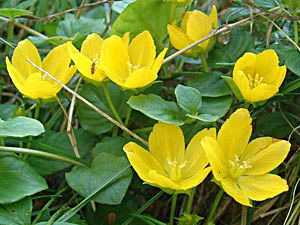
medicinal herbs
Creeping Jenny
Lysimachia nummularia

Herb: Creeping Jenny
Latin name: Lysimachia nummularia
Family: Primulaceae (Primrose Family)
Medicinal use of Creeping Jenny:
The whole herb, used fresh or dried, is antiscorbutic, mildly astringent, diuretic and vulnerary. For drying, the herb is harvested in June. Creeping Jenny is a very good wound-herb, the fresh leaves being bruised and applied externally to the affected area. An infusion is used to treat internal bleeding and diarrhoea.Description of the plant:

Plant:
EvergreenPerennial

Height:
15 cm(6 inches)

Flowering:
June toAugust
Habitat of the herb:
Damp situations in pastures and by the sides of streams, avoiding acid soils.Edible parts of Creeping Jenny:
A tea is made from the leaves and flowers.Other uses of the herb:
Can be used as a ground cover plant in moist soils but requires weeding for the first year or so. Plants should be spaced about 60cm apart each way and form a carpet, rooting as they spread.Propagation of Creeping Jenny:
Seed - sow spring or autumn in a cold frame. This species rarely produces seed in Britain. When they are large enough to handle, prick the seedlings out into individual pots and plant them out in the summer. Division in spring or autumn. Larger clumps can be replanted direct into their permanent positions, though it is best to pot up smaller clumps and grow them on in a cold frame until they are rooting well. Plant them out in the spring.Cultivation of the herb:
Damp situations in pastures and by the sides of streams, avoiding acid soils.Known hazards of Lysimachia nummularia:
None knownPlant information taken from the Plants For A Future.
